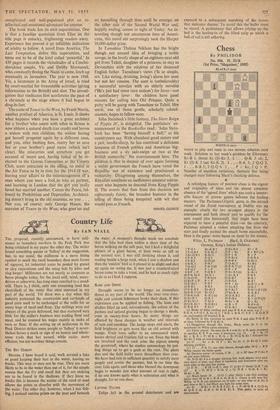Chess
By PHILIDOR No, 104. H. ZUK (1st Prize, `Magasinet,' 1955)
BLACK (5 men) WHITE (6 men)
WHITE to play and mate in two moves:. solution next week. Solution to last week's problem by Ellerman: Kt-B 1, threat Kt (5)-Kt L. I. : . . Q-K 5 ch; 2, Kt (5)-K 3 (set Kt-K 2). 1 . , '.: B-K 5; 2 QTQ 2.. I . • . B-13 5; 2 Q-Q 4. I . . . P x Kt; 2 Q x P. Number of excellent variation's, thematic line being' changed mate following Etlack's checking defence.
A refreshing feature of postwar chess is the vigour and originality of ideas and the almost complete absence of the 'agreed draw' which was such a lament- able feature of prewar games between the leading , masters. The Pachman-Gligoric game, in the. second round of the Zonal tournament at Dublin was alp example: clearly the two strongest players in the tournament and both almost sure to qualify for the next round (the Interzonal), They' might have beer) expected to have a peaceful draw—on the contrary,' Pachman adopted a violent attacking line from the start and finally pushed the attack home successfully,. Here is the game: notes based on those by the winner...
White, L. PACHMAN Black, S. GL1GORIC Opening, King's Indian Defence.
1 P-Q 4 Kt-K B3 22 Kt-R 4 Kt x 13
2 P-Q 11 4 P-K Kt 3 23P x Kt B x Kt? (f)
3 Kt-Q 11 3 13-Kt 2 24 P x B R x P 4 P-K 4 P-Q 3 25 P-Kt 6 P-K R 4 5 P-B 3 0-0 (a) 26 B-R 4 Q-Kt 2 6 B-K 3 P-B 3 27 Q-Kt 2 Kt-B I
7 Q-Q 2 P-K 4 (b) 28 B-K 7! (g) B-Q 2
8 P-Q 5 P x P 29 B x P R-Q 1
9 BP xP P-QR 3 30 Kt-B 5 (h) K-Kt I
10 P-K Kt 4 Kt-K1 31 Kt-K4 P-R 4 11 0-0-0 P-B 4 (c) 32 B-B 7 R-R 1 12KtPxP PxP 33 B-Q 6 R-13 1 13 K-Kt 1 P-B 5 34 B x Kt II (I3 1) x Tr 14 B-B 2 B-B 3 35 Kt-13 5 Q-K 2 15 P-K R 4 Kt-Kt 2 36 P-Kt 7 R (B 1)-B 3(0 16 B-R 3140 Kt -Q 2 37 Kt-K 4 R-K R 3
17 B-K 6 ch K-R 1 (e) 38 Q-K B 2 R-B 2
18 Kt-R 3 Q-K 2 39 P-Q 6 R x Q P? WI 19 Kt-Kt 5 P-Kt 4 40 Kt x R Q x Kt 20 Q R-Kt 1 R-Q Kt 1 41 R x P B-B 4 ch
- P-Kt 5 42 K-R 1 Resigns (A) (a) Better to delay castling and play P-K 4 at once, e.g. 5 . P-K 4; 6 P-Q 5, K Kt-Q 2; 7 11-K 3, 11-R 31; 8 11 x B, Q-11 : .. 5 ch, exchanging off blocked K B.
(b) Better in this variation to omit P-K 4 and play P- Q R A at once, followed by P-Q Kt 4. (c) Dangerous though this looks, Black must do it or bcr smothered by White pawn advance.
(d) Finely played. He aims for K 6 with Kt or B. quite prepared to sacrifice K R P en rouge if necessary. e.g. 16 . . . B x 11; 17r Kt x B, B X P; 18 B x B, Q x B; 19 Q R-Kt 1 followed by' Kt-Kt 5 with an overwhelming attack. (e) 17 ., . . Kt x B; 18 P x Kt, Kt-Kt 3; 19 K1-Q 5 with winning position. (f) 23 . . . P-K 5!; was only chance, though after 24 Q x B P' White retains the better game. (g) Decisive move: of course, if 28 • .. Q x B? then 29 P-Kt 7 ch and mate follows.
(h) 30 Q-Kt 4 is a simpler winning line: both pOayers were now, very short of time, and there is repetition and inaccurate play ma both sides in the next few moves. (1) If 36 . . . R (B 1)-B 2; then 37 Q-Kt 6! threat Q-R. 7 cla (37 . . . R x 1'; 38 Q x R ch, Q x Q; 39 R x Q ch, K x R; 40 Kt x B).
(J) Much better 39 ... Q-Q II after which I can find nothing; better than 40 Q-B 5, R--B 4; 41 R-R 2. Game is still won for White, as K R can penetrate on Q side—or else play to K Kt 2 and then to Kt 5. but Black can fight for some time. (k)13-Kt 3; 43 ch!, K x P; 44 Q-R 4, Q-Q 6z 45 Q-R 6 ch, K-B 3; 46 R-K Kt 8. Fine game, ia spite tai inaccuracies.










































 Previous page
Previous page